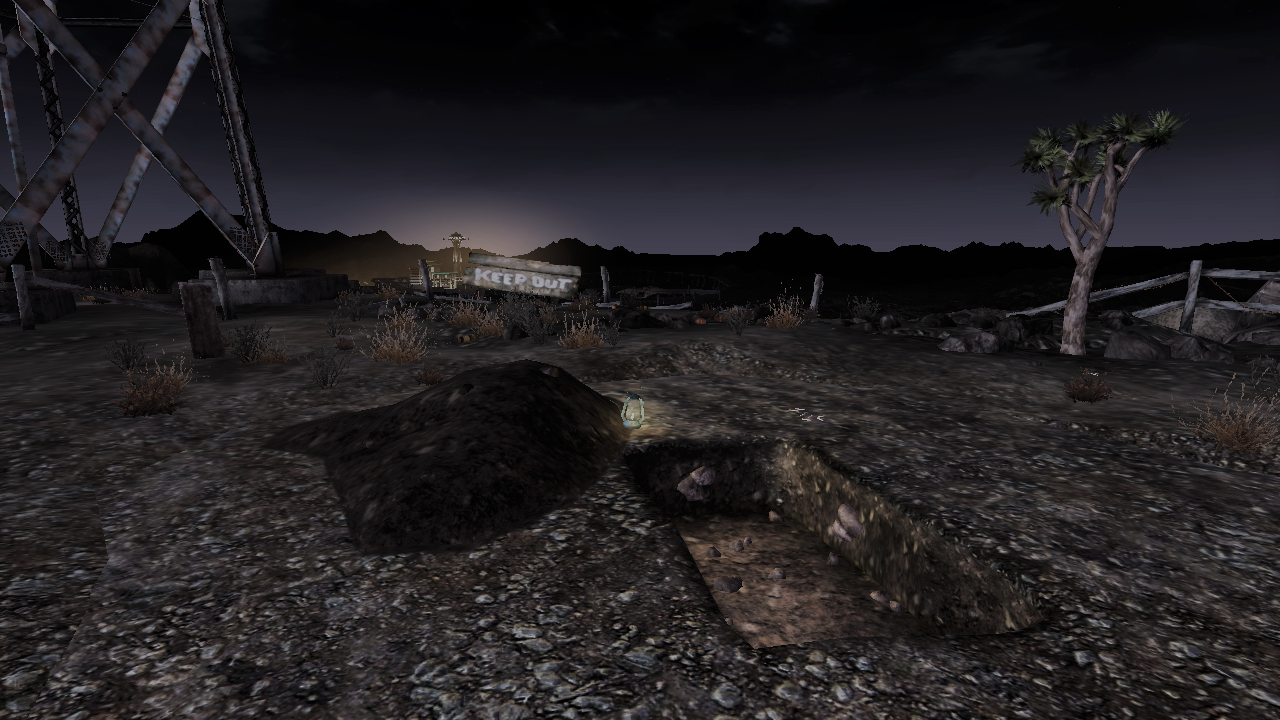The Legacy of Fallout New Vegas
Mark Warren revisits the unique world of one of the Fallout series' most beloved entries and dissects what continues to make it stand out almost a decade after its release.
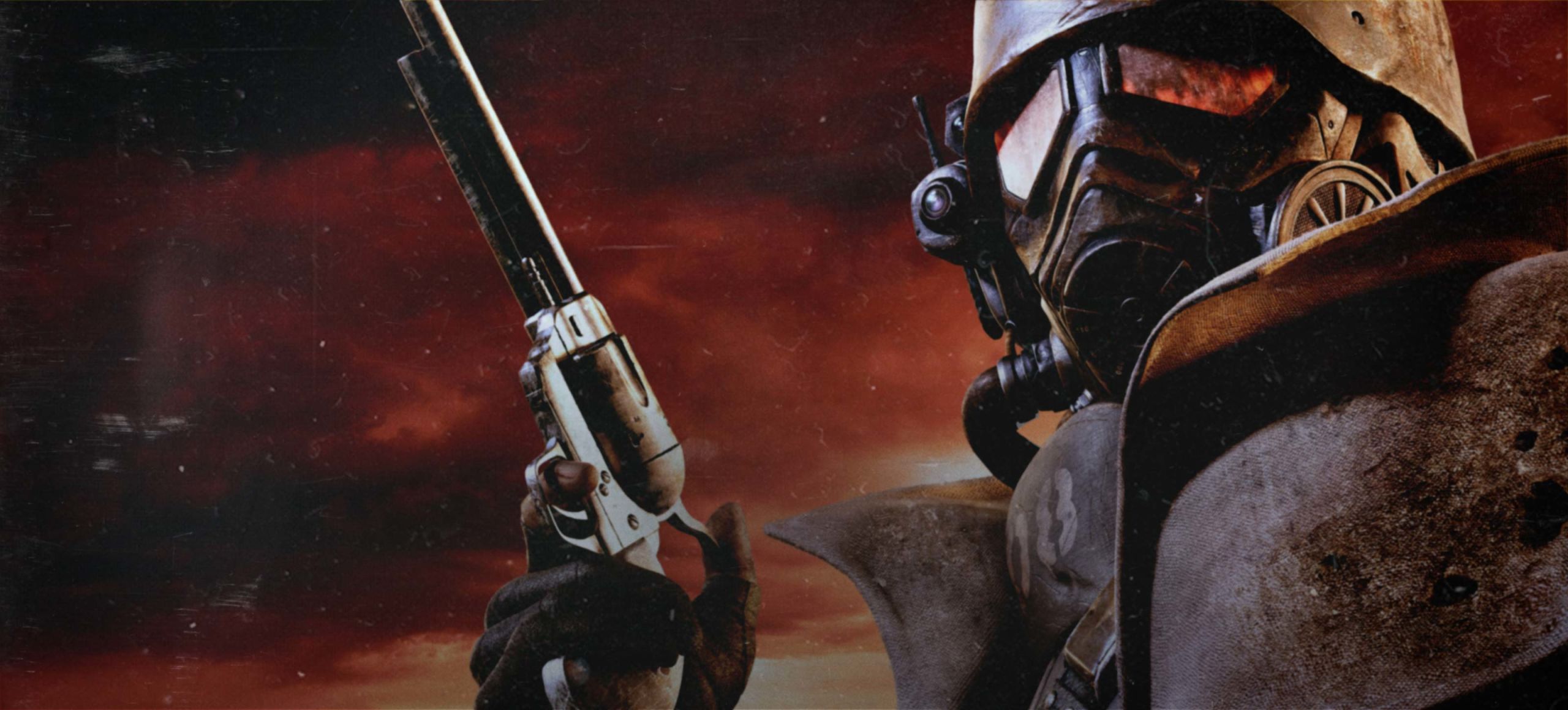
Ten years ago this October, gamers around the globe were delving into a new world.
For the first time, they witnessed the glittering neon lights and bustling drunken revelry of the New Vegas Strip, as Frank Sinatra’s dulcet tones echoed in the background. Then, they were quickly dragged back to reality by the brutal and bloody sight of a raider’s head being blown off by a sniper’s bullet.
They were regaled with tales of a war over a city once devastated by nuclear armageddon and of a brewing battle that would irreversibly alter its future.
They learned of the key players in this battle, an expanding republic from New California, dedicated to restoring the world that once was, and a barbaric Roman legion forged from the enslavement of 86 tribes, dedicated to stopping the republic in its tracks.
They were told of New Vegas, stuck between the two sides, ruled by a mysterious overlord named Mr House and his robotic army, seemingly clinging on to its independence by a thread.
Then, the focus shifted away from weighty ideological struggles and the looming shadow of war, as they were introduced to their place in this new world.
They were a simple courier, whose job had taken a turn for the worse.
Suddenly, they found themselves tied up, in front of a man in a chequered suit and his hired goons.
He politely explained to them that it was a shame they’d ended up in this situation, but that now, they had to die.
Then, just as they might have been expecting a rescue, he shot them in the head.
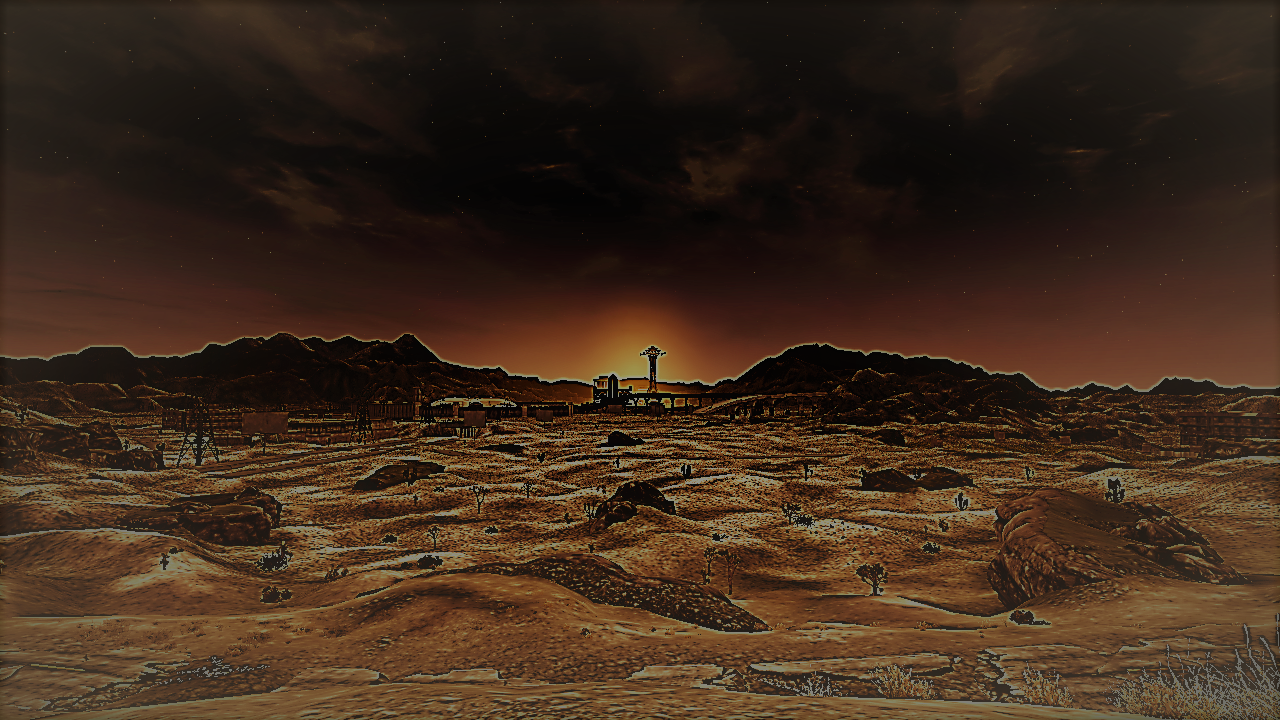
When you think about Fallout: New Vegas today, almost ten years on from its release, odds are a multitude of things come to mind.
The song ‘Johnny Guitar’, being mercilessly hunted by cazadores or simply the phrase ‘Patrolling the Mojave almost makes you wish for a nuclear winter’, for example.
However, I’d wager, etched into your psyche next to all of those wonderful little memes and inside jokes, is something that New Vegas’ developers definitely intended for you to associate with their game ten years later.
Walking into the New Vegas Strip for the first time.
It’s a moment that they wanted you to remember so badly that they split the strip up into three sections to make sure that the game wouldn’t crash and ruin it for you.
And it’s one that still holds up ten years on.
Now, don’t get me wrong, without the aid of mods, the Strip on its own no longer has the same visual impact today that it had in 2010.
Ten years of technological and graphical development and the natural raising of the bar in terms of gaming ‘wow’ moments that accompanies those advances will do that.
Yet, I’d argue it remains the most iconic and impressive location in the modern Fallout franchise.
With its glittering architecture, gaudy colours and ephemeral glow, it just feels special, like a beacon of hope in the destroyed world of the Fallout universe.
Despite the fact it's definitely and unapologetically a city of sin, where sketchy characters lie, cheat and steal their fortunes, it still exudes a tacky, infectious kind of charm that you can't help being enticed and enthralled by.
Enter any of its casinos and you'll be greeted not only by the sight of slyly shuffling decks and ceaselessly spinning roulette wheels, but by the snappily dressed contingent running the place.
No matter whether this is the rat-pack inspired Chairmen, the gangster movie styled Omertas or the unnerving, masked White Glove Society, you can be sure that they're hiding some dodgy dealings and scandalous secrets for you to discover, if you dare.
Taken as a whole, the likes of Fallout 4’s Diamond City or Fallout 3’s Rivet City, while decent, simply pale in comparison to it, but this isn’t just because of some neon lights, fashionable proprietors and dancing prostitutes.
It’s because, on top of all this, the Strip is a physical representation of one man's personality. A man who happens to be the most interesting character in the modern Fallout franchise.
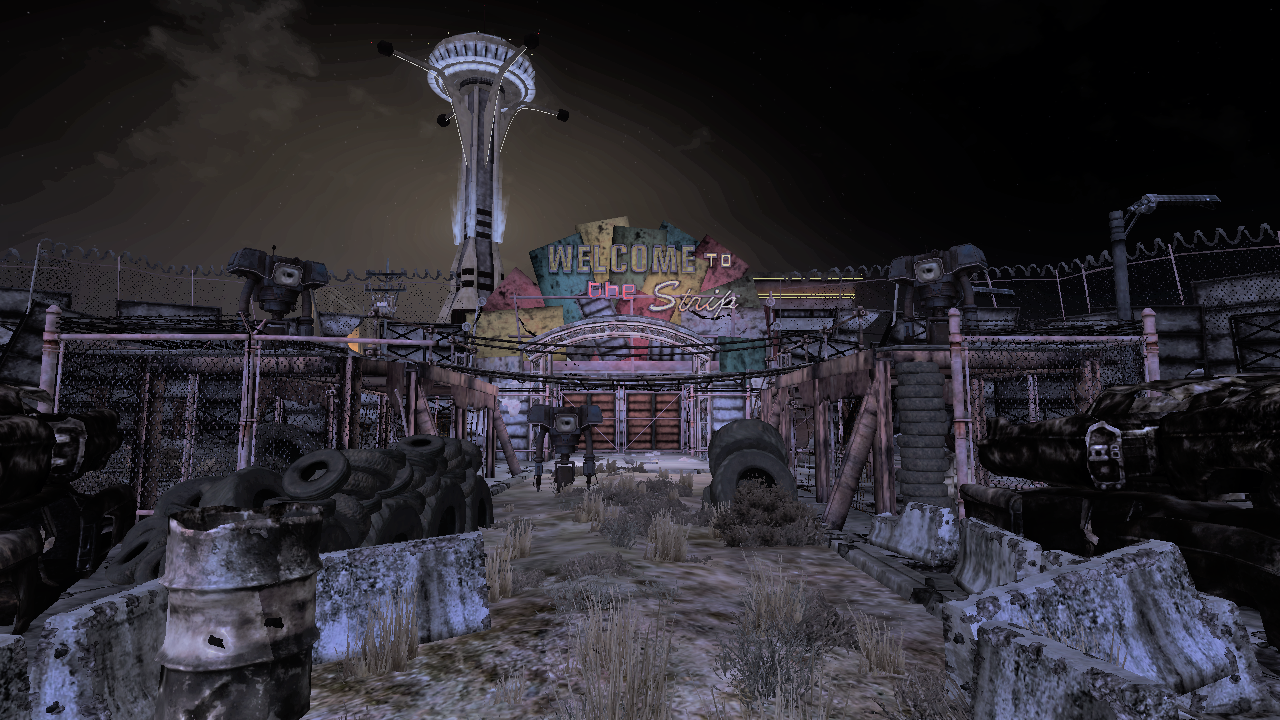
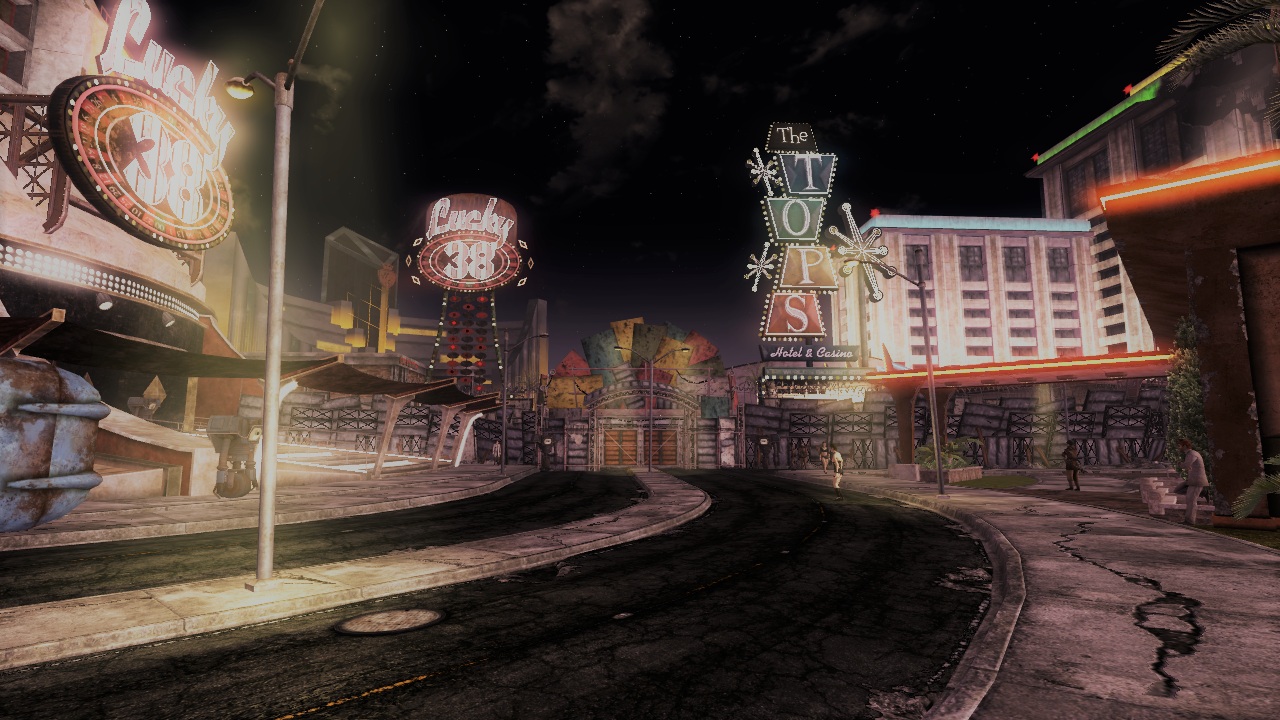
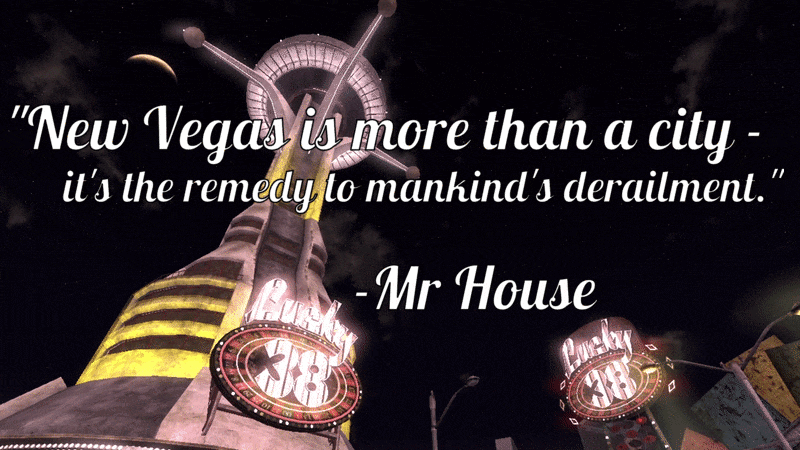
Robert Edwin House.
A pre-apocalypse business and robotics mogul, turned ruler of the desert metropolis that he saved from the cataclysmic wrath of the atomic bomb.
As more intelligent people than me have pointed out, Mr House as a character basically IS Fallout.
In my opinion, he's also one of the most intriguing and well-written characters in gaming.
Not only is he an engaging antagonist or ally, depending upon your choices, but he provides a stark and bold contrast to the rest of the colourful cast of the Mojave wasteland.
So what do I mean by contrast? Well, firstly, he’s one of only a select number of characters in the game who can claim to have seen the world before it was reduced to rubble, however, unlike the rest, House isn’t a ghoul or mutant.
Instead of relying on a freak reaction to nuclear radiation, he survived the apocalypse through his own ingenuity and intellect. By essentially integrating himself into a gigantic computer in the penthouse of his casino, House achieved immortality on his own terms.
As a result, speaking to Mr House arguably feels more like conversing with a god than a man.
He speaks with a commanding and confident cadence, offering a myriad of enticing deals in exchange for your agreement to act as his vessel, as the hands that mould the Mojave to fit his vision.
In a game world containing ghouls and super mutants, House, as a flickering display of pixels on a screen, entombed at the summit of his neon tower, high above the everyday struggle for survival in the wasteland below, feels like the character most detached from humanity.
Just as the glittering lights, dapper suits and economic excess you see on the Strip seem alien when you’ve spent the last few days in-game trudging along barren desert highways and through small communities of people fighting to survive, House’s robotic appearance and pre-war capitalistic philosophy make him feel massively different to even the leaders of the factions he’s fighting against, let alone the common wastelander.
And, in a role-playing game, that kind of deep and interesting characterisation is what makes the choices and decisions the player has to make so much more meaningful and difficult.
Deciding whether or not to kill Mr House is still one of the weightiest and most thought-provoking decisions a gamer can face in 2020.
Are you depriving the people of New Vegas of a visionary who was their one true hope for re-building humanity or are you overthrowing a tyrant? Are you doing it for noble reasons, or are you hypocritically murdering a despot, only to take his place yourself or to anoint someone else who will?
Are there any other Fallout characters, aside from maybe The Master, from the franchise’s very first entry, whose fate sparks such a stark and thought-provoking ethical dilemma?
Even choosing to betray your own son in Fallout 4 just doesn’t have the same impact.
Whatever you choose regarding House’s fate, New Vegas won’t hesitate to show you the consequences of your actions for the rest of the population of the Mojave.
The developers even wrote him an obituary, which tells you in no uncertain terms just whose life you’ve chosen to end.
Entitled ‘A tragedy has befallen all mankind’, the obituary, authored by House himself, berates you for snuffing out humanity’s last hope and describes House in such grandiose and overzealous terms that one could easily draw from it the conclusion that he genuinely believed he had achieved godhood.
God is dead.
And you killed him.
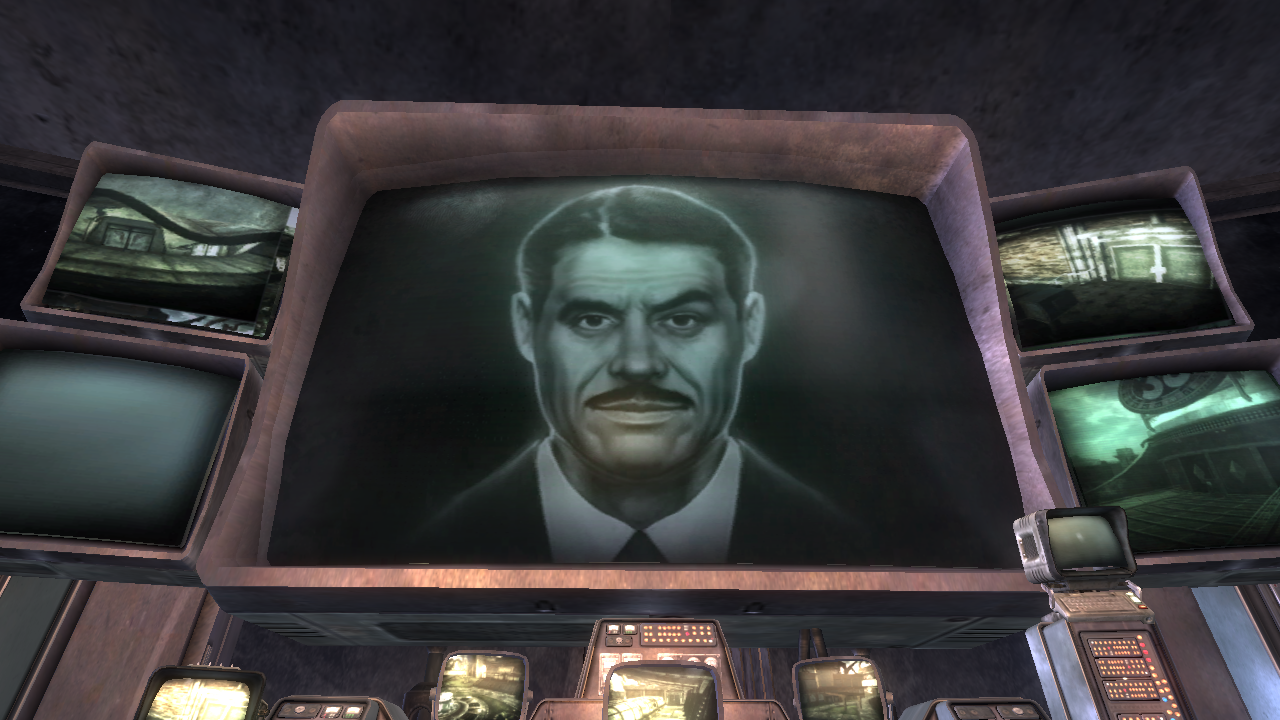
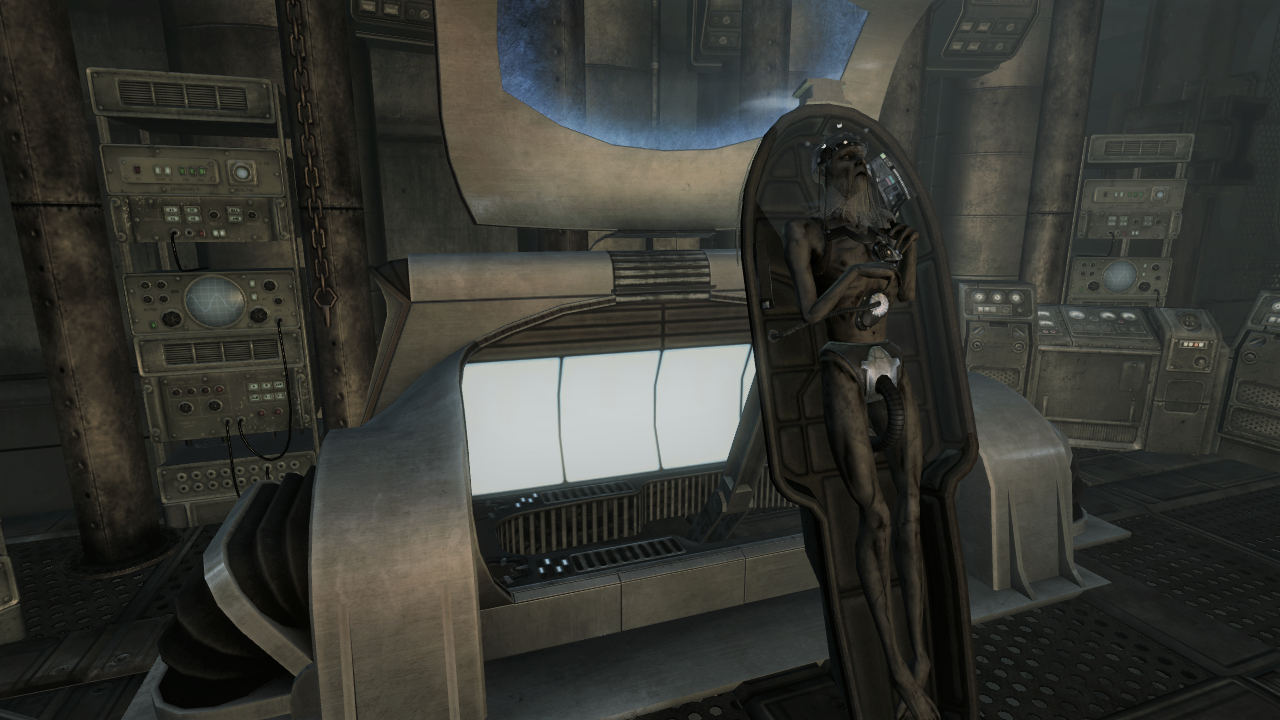
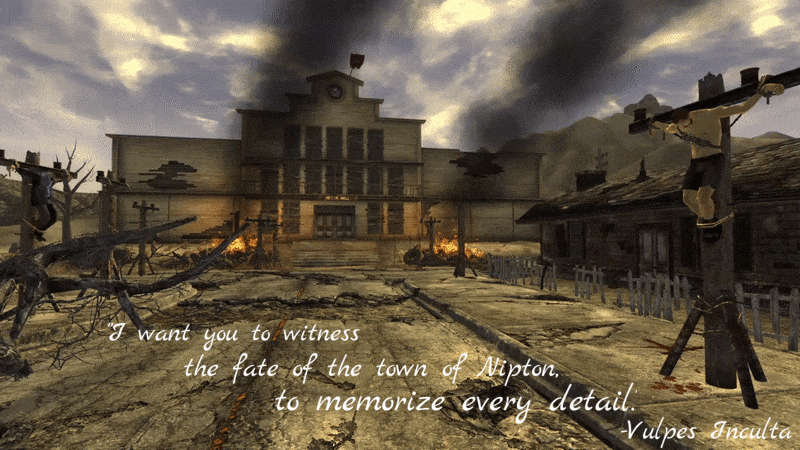
Despite Mr House’s lofty beliefs regarding his importance to mankind, his influence over the majority of the wasteland and its population, beyond his immediate domain of the strip, is shown to be minimal at best.
During your trek through the southern reaches of the Mojave, as you follow in the footsteps of the man who performed 9mm brain surgery on you, House’s New Vegas arguably takes a back-seat to the game’s primary conflict, the war over Hoover Dam, being fought between the New California Republic and Caesar’s Legion.
One of the first things you, the player, learn about this war is that it’s much bigger than you.
By the time you wake up in Doc Mitchell’s house in Goodsprings, the war has already been raging for just over four years.
Battles have been fought, lives have been lost and the Mojave wasteland has been irreversibly changed by the war, before you’ve even taken your first step on the Nevada sand.
As a lone individual, emerging into a world dominated by huge armies engaged in a titanic struggle that seems like it’ll continue with or without your input can leave you feeling powerless at first.
And it should.
This feeling of powerlessness is what makes the war feel real and authentic. For at least the first act of the game, it’s something that ravages the world around you, that you can’t control.
The very first town outside of Goodsprings you’ll most likely visit as you emerge into the Mojave is Primm.
You’ll quickly discover it’s crawling with armed convicts who’ve taken the town’s residents hostage. You’ll find out that these convicts have recently escaped from an NCR prison.
However, even though a battalion of NCR troops are camped right next to the town, they won’t help you deal with the convicts because they don’t have enough reinforcements or equipment to do it without risking being unable to follow their orders to protect the highway to the south.
So, you’ve got to take on a band of highly dangerous armed men by yourself.
Once you have, odds are you’ll then continue south-west, eventually reaching the town of Nipton.
Alarmingly, you’ll discover it burning and destroyed, its streets littered with the charred and crucified bodies of its citizens and the unrepentant culprits, a single battalion of Caesar’s legionnaires, emerging from the town hall.
You can kill these legionnaires for their crimes, but you can’t save the townsfolk of Nipton from them.
Experiences like this are a wonderfully immersive way of introducing the player to the power dynamics of the Mojave, from the point of view of your average wastelander.
The Legion are shown to be the wasteland’s bogeyman, a terrifying and increasingly ominous presence, whose cruelty and brutality is shocking to behold.
The NCR, while being shown to hold noble values and sentiments, are clearly less effective than the Legion, being held back by bureaucracy and, as a result, have a strained relationship with the residents of the Mojave, who view them as too weak to offer protection from even roving bands of raiders and convicts, let alone the Legion, but just strong enough to enforce taxes.
Then, in the middle of all this, there’s you. You might be more capable than most of those around you, but at the end of the day you’re just one person.
You’re no superman, at least not yet and the people around you are caught up in events beyond your control, being presided over by figures you’ve only heard of up until this point.
In addition to showing you where the power lies in the Mojave, these events also do a great job of making you feel the trepidation and fear inflicted upon the wasteland populace by the war, setting up the gritty atmosphere that resonates throughout the world outside of the colourful bubble of the Strip.
They also force you to witness the consequences the future decisions of you and the wasteland’s warring factions may have for the Mojave’s residents in their struggle to survive in the post-apocalyptic world, in turn making that world feel more alive and dynamic.
This contrasts with Fallouts 3 and 4, where the central conflicts often seem like their impact on the population is relatively minimal, with life going on almost as normal in many places, creating a jarring atmosphere, especially as tensions rise and battles become more frequent.
New Vegas’ conflict doesn’t wait for you to get acquainted with and comfortable in the world before it starts to ramp up the stakes by triggering a slightly jarring escalation, such as the Brotherhood of Steel and the Enclave’s sudden arrivals in the main plots of Fallout 4 and Fallout 3 respectively.
All of the players are already at the table, cards in hand and you’re the late arrival, invited to play at the last minute.
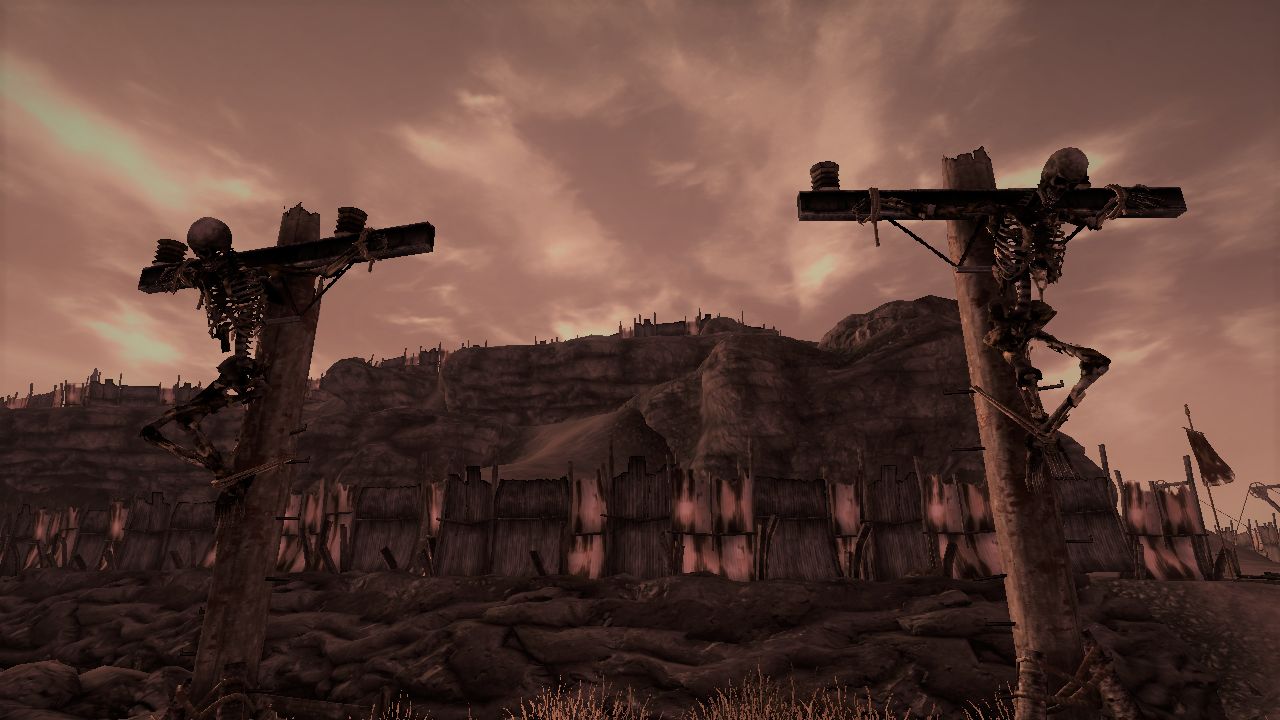

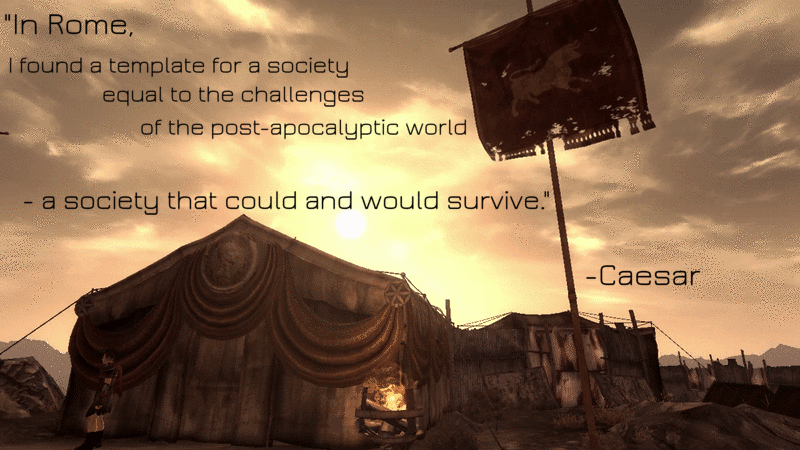
One of these key players goes by a name that inspires more terror than the rest.
Caesar.
A dictatorial warlord, the self-proclaimed son of Mars and a would-be emperor seeking to plant his throne in the Nevada soil.
Caesar is many things, but above all, he’s the principal embodiment of fear in the Mojave.
Before you meet him, you witness first hand some of the unspeakable atrocities committed in his name, by soldiers who follow his orders to the letter.
Therefore, when you’re formally invited to an audience within the impenetrable walls of his fortress just beyond the banks of the Colorado, these experiences likely weigh quite heavily on your mind.
Whether you travel there with the goal of finally securing your stolen platinum chip once and for all, or simply to hear him out as a courtesy for recognising your importance as a force within the wasteland, you know you’re walking into a lion’s den.
The sights that greet you upon your arrival at Fortification Hill do nothing to dissuade your preconceived notions.
Crucified NCR soldiers, heads on pikes and swarms of legionnaires armed with a slew of weaponry are yet more symbols of Caesar’s might.
Reminders of the man you’re about to meet, whose tent sits on a rise in the centre of the camp.
Entering this tent, you’ll find him sitting on a jagged throne, surrounded by his praetorian guards, seemingly awaiting your arrival.
He knows exactly who you are and greets you as the courier he’s heard so much about, before referencing some of your previous actions in-game.
Naturally, at this point, you can agree to start helping him to take over New Vegas, beginning the Legion main quest-line, but, you can also do something else.
You can ask him to explain himself.
Now, from what you’ve seen so far, you might expect deflection, or the simple admission that he wants to watch the world burn.
However, that’s not the case.
When asked to justify his violent crimes, Caesar instead cites old world philosophy and uses logical reasoning to attempt to convince you of the sense in what he’s doing.
He argues that his principal enemy, the NCR, are a critically flawed society, plagued by the same corruption as the society which destroyed itself with nuclear weapons and led by politicians and businessmen driven only by greed, rather than acting in the interest of the greater good.
Therefore, he concludes, they are doomed to repeat the same mistakes which led the world to end in the first place.
This, in his opinion, fuelled by the philosophical idea of Hegelian Dialectics, makes it necessary for them to be destroyed.
He believes his legion can offer an alternative, as a society of people who all work in direct service of the state, to achieve a common goal.
There are no diverse identities, no powerful interests and, most importantly, no in-fighting.
Everyone works to provide their ultimate value to the state, to Caesar, which he believes stands his society in good stead to offer humanity a different and better future.
Now, there are a litany of reasons for which you can disagree with Caesar’s views, so many that I won’t name them here, but the presence of a possible justification for his actions in the game, in my opinion, is extremely important.
Caesar’s Legion could easily have been a one dimensionally evil faction, of the kind that are seen in innumerable works across all creative mediums.
However, the existence of concrete and fleshed out reasons that could justify supporting them, despite their heinous actions, as well as making them much more interesting, is incredibly important for role-playing.
It means that, when creating a character who you want to side with the legion, you aren’t just limited to creating cartoonishly evil characters with no redeeming qualities.
Instead, you can create a range of more morally ambiguous figures.
Characters a bit like Caesar himself, whose past experiences growing up in the NCR and being a Follower of the Apocalypse have shaped his unorthodox and controversial world-view.
You don’t just have to create bloodthirsty, emotionless monsters.
Though, if you side against the Legion, you may just have to face one.
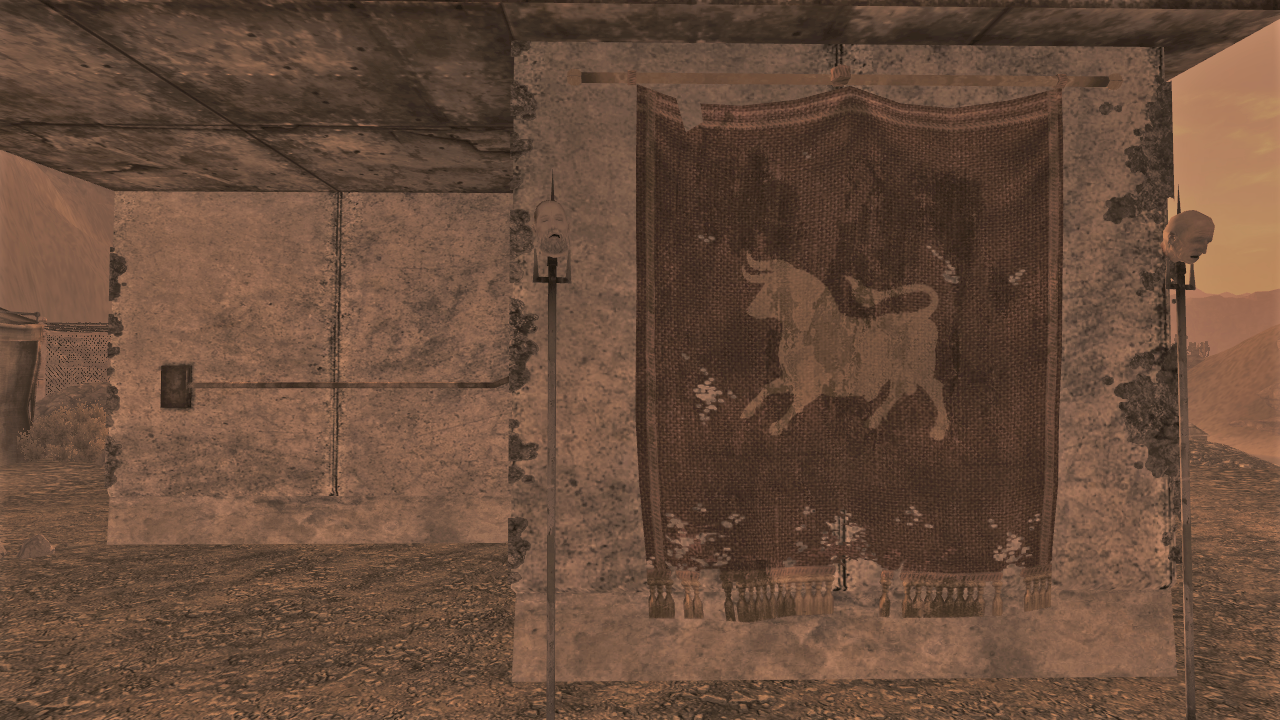
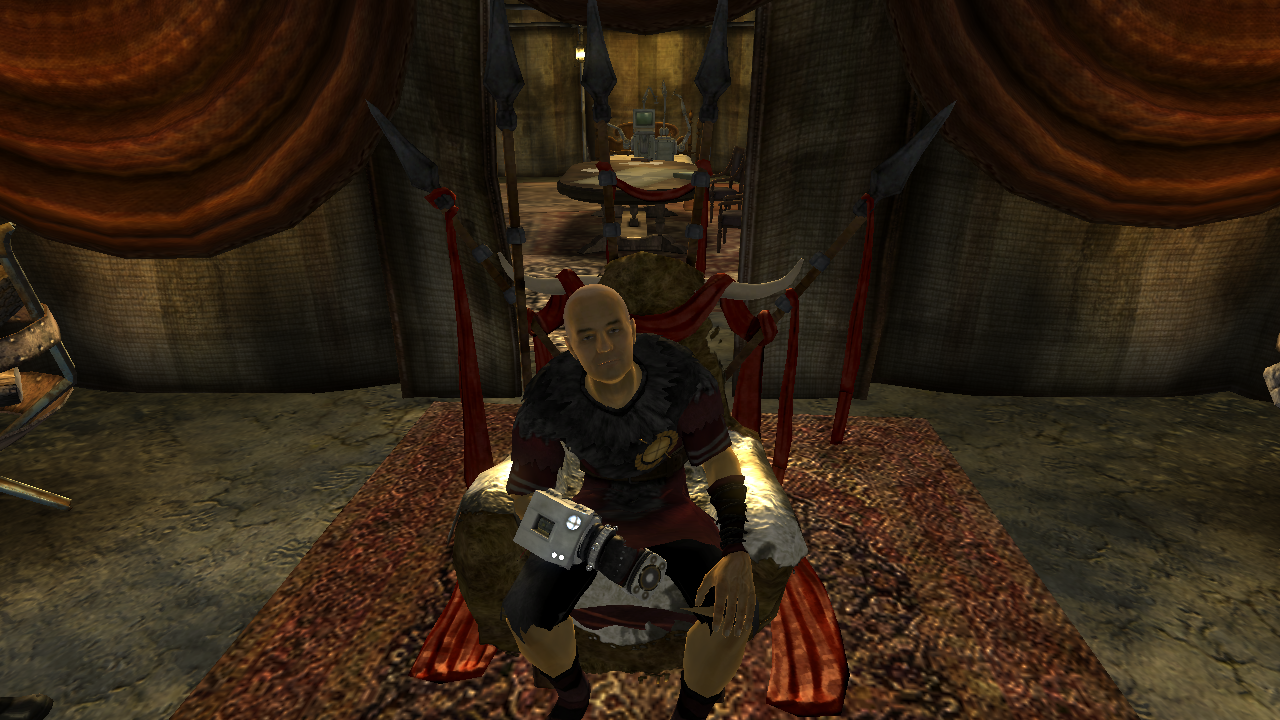
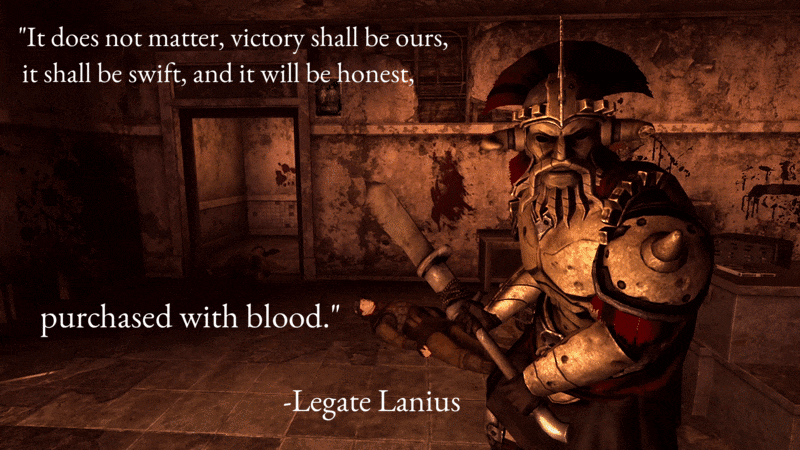
When I said that Caesar inspires the most terror in the wasteland, I wasn’t telling the whole truth.
As, while the leader of the legion certainly is someone the people of the Mojave should fear, he lacks some of the carefully cultivated, frightening aura that surrounds his second-in-command.
Legate Lanius, the Monster of the East, is arguably more myth than man.
During your travels throughout the world, you’ll hear numerous tales and rumours about the Legate.
You might be listening to the radio, when Mr New Vegas stops the music for a few minutes to tell a tale of Lanius, describing his methods for improving an under-performing squad of troops: by beating its commander to death in full view of everyone and then ordering the remaining soldiers to kill a small group of his soldiers in order to prove themselves.
You might bring him up in conversation with a number of legion personnel and be told more tales, suggesting a multitude of things, including that he became a full legionary at the age of 12, that all of his personal slaves are blinded so they can’t witness him without his mask and that he has never lost a battle in his life.
Eventually, you might muster up the courage to ask Caesar himself about the Legate’s origins, which will cause him to recount a tale of a legendary warrior from a tribe in Arizona, who could wipe out entire Legion patrols single-handedly and who was so enraged when that tribe surrendered to the Legion that he began to kill his fellow tribesmen, only stopping when most of his face was torn off.
Caesar will tell you that he then had Lanius nursed back to health and offered him an iron mask to cover his disfigured face, on the condition that he join the Legion.
He’ll finish by telling you that Lanius only accepted on the condition that he could wipe out the rest of the men from his tribe.
And, until the very end of the game, this conjecture will be all of your experience of Lanius.
As a result, Lanius becomes like New Vegas’ version of Beowulf’s Grendel, portrayed as a ruthless and semi-human monster, enveloped by a fog of mystery.
He’s also clearly inspired by Darth Vader in the original Star Wars trilogy, a powerful, faceless foe who prowls the world, carrying out the orders of his Emperor and leaving destruction in his wake.
Thankfully though, he isn’t your dad (unless you role-play that, I guess).
Of course, all of this makes the butcher of the east a memorable boss to battle at the end of most play-throughs.
I’d even go as far as to say that, in a world where video game final bosses are often charismatic characters who pop up frequently throughout the game to antagonise the player, Lanius as an antagonist is rather old-school.
He doesn’t appear at the start or even halfway through the main story to meet you for the first time and attempt to intimidate you. Instead, he doesn’t even acknowledge you until you blast your way into his camp at the game’s climax.
When you do, you can either take on the difficult task of convincing Lanius to turn back east or attempt to best him in combat.
Whatever you choose, the game can’t end until you’ve satisfied or defeated the Legion’s secret weapon, who may never have met a worthy opponent, had you not come along.
Though, the folks sitting across the river from Lanius’ camp might dispute that.
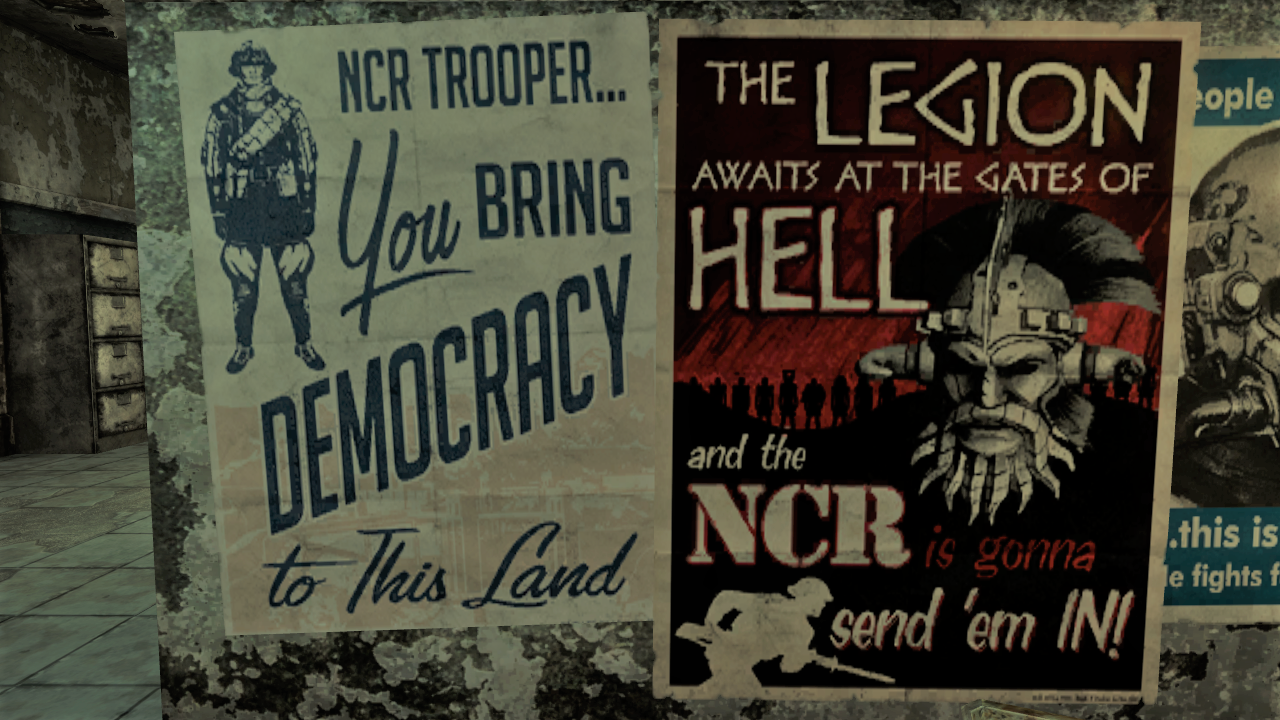
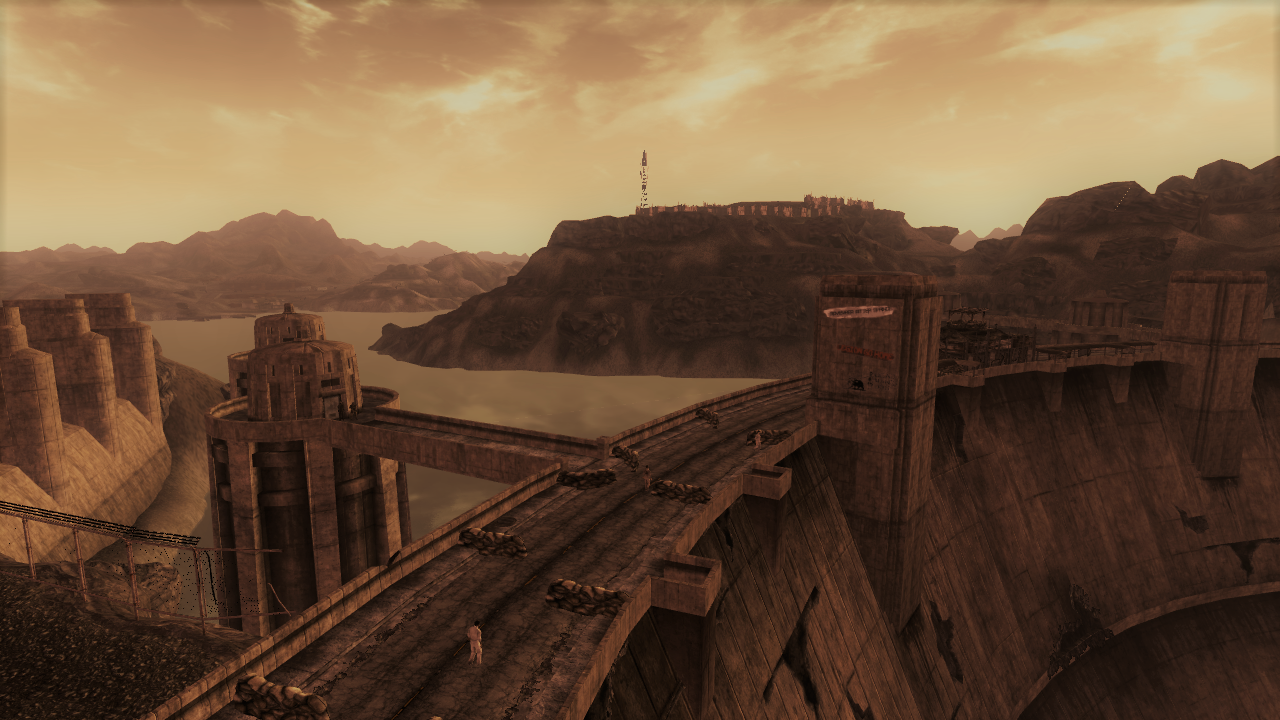
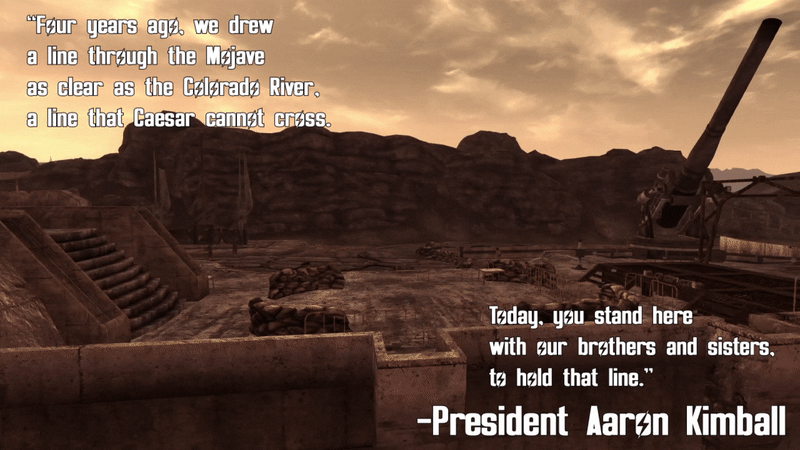
While your possible climactic face-off with Lanius at the end of the game might be the only outcome that sees the Monster of the East find his equal in one-on-one combat, the leaders of the New California Republic would argue they’re still very capable of defeating Caesar’s field commander without ever having to take him on in an arena-style fight.
They’d likely argue that tackling Lanius in this way represents an unnecessary risk, that it’s not the way a modern military force should try to win its wars.
That it, in a way, shows the backwards mindset of the Legion to believe that one mighty warrior can win battles by relying mostly on his own individual fighting prowess.
They’d argue that a commanding officer’s place should be in the war room, devising strategies and directing his troops to do the fighting for him.
In line with this philosophy, the NCR’s leaders, on the face of it, are a lot less mythical and intimidating than their Legion counterparts.
The faction’s overall leader, President Aaron Kimball, is just a politician, a man in a suit. He’s not a warlord who claims to be the son of a Roman god.
He’s just a man, and one who, if you believe widespread public opinion, might not even be in office for that much longer.
His chief military commander for the upcoming second battle over Hoover Dam, General Lee Oliver, suffers a similar reputation.
The pair are widely seen as narrow-minded, warmongering glory hounds, who’ve chained their futures to the success of their expansionist military campaign into the Mojave and, if this campaign fails, Kimball and Oliver’s careers, having been temporarily propped up by cronyism, will almost certainly be done for.
However, having the sword of Damocles hanging over both of their foremost leadership figures doesn’t make the NCR a weak faction, because it’s more than capable and willing to replace them.
Because the NCR is bigger than just Kimball and Oliver.
Its greatest strength lies not in the individuals who lead it, but in its ideological versatility, which allows it to re-incarnate itself by replacing its leadership with new, possibly more effective candidates whenever it needs to.
Even if President Kimball is brutally murdered by a Legion assassin in the lead up to the battle, rather than being impaled on a sword of democratic votes down the line, it doesn’t mean the end for the NCR.
Sure, troop morale might take a hit, but Kimball’s death via bullet, knife or bomb is nowhere near as cataclysmic for the NCR as Caesar’s death from an untreated brain tumour can be for the Legion.
The faction’s immediate existence and future simply can’t be thrown into jeopardy by the removal of a single person from the picture, because it’s not a dictatorship built entirely around a singular cult of personality.
Instead, for better or worse, it’s a democracy.
This stark difference between the two sides is a huge reason why their conflict is so fascinating.
I’m not an encyclopedia when it comes to real-world history, so I may well be wrong, but I can’t think of any war from our history which pits such polar opposite enemies against each other, in which both sides were of a comparable strength.
We’ve never seen a modern, western-style capitalist democracy take on a dictatorially-ruled empire, largely governed by ancient principles, in open warfare before.
We definitely haven’t seen it in a world where both modern and futuristic weapons also exist and are available for both sides to utilise.
That’s what makes this titanic clash in the desert such a unique demonstration of what games can do in terms of storytelling, in my opinion.
Through the medium of a post-apocalyptic role-playing game, the developers of Fallout New Vegas allow us to witness and explore first-hand how a conflict the likes of which we have never and may never see in the real world might look like, in a way that’s arguably more immersive than if it were depicted in a film or described in a book.
Plus, it also gives us the power to decide to completely disregard both sides of this conflict, siding with neither the NCR or the Legion, in favour of either taking your place at Mr House's side or doing what everyone really wants the opportunity to do:
Take over the world for yourself.
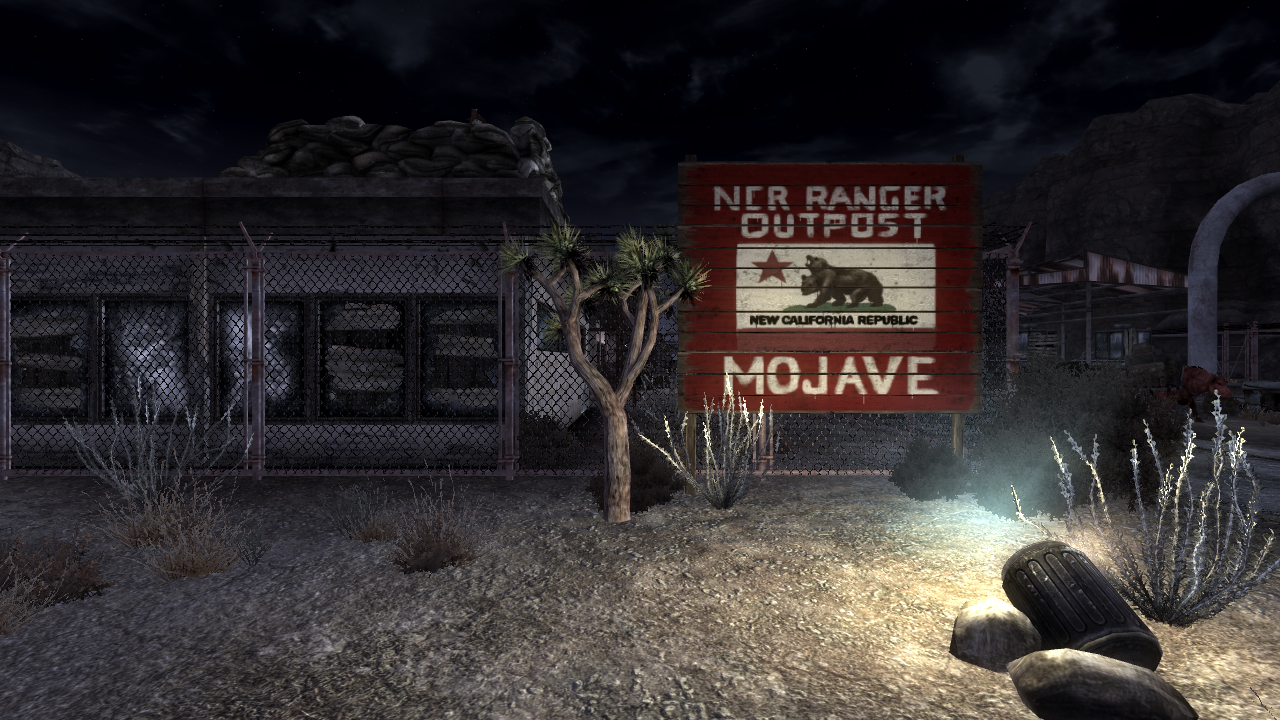
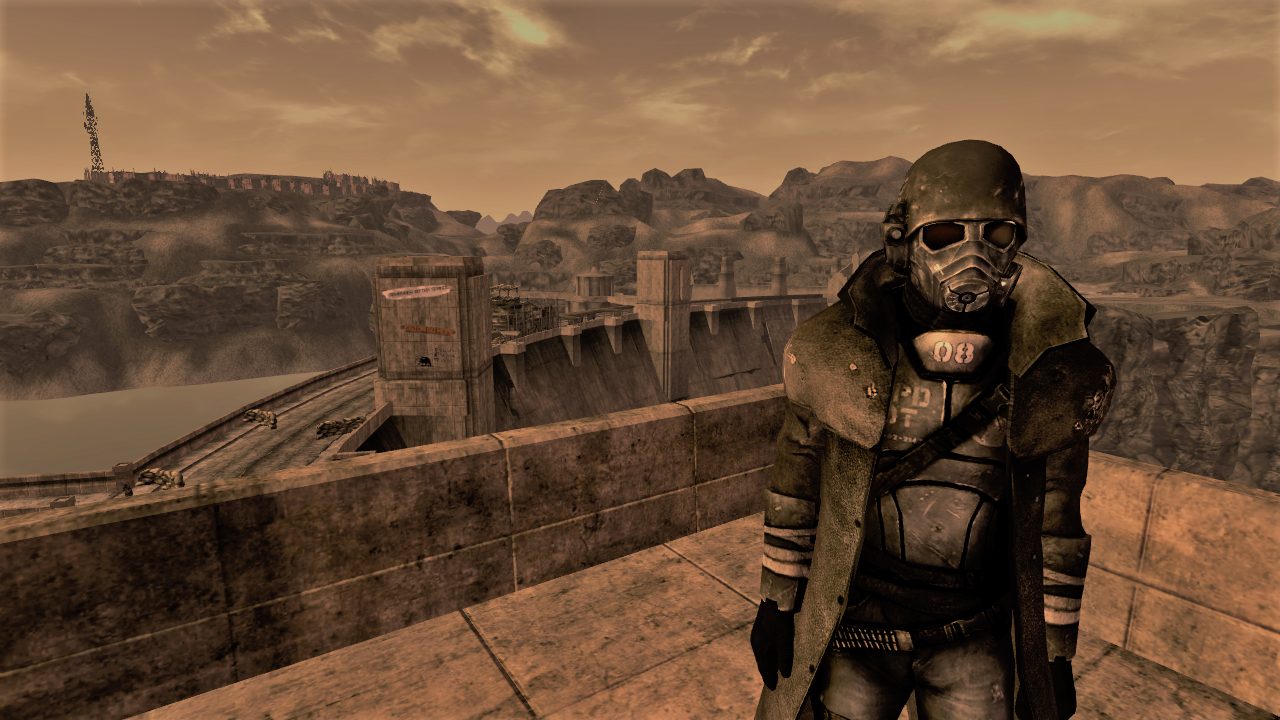
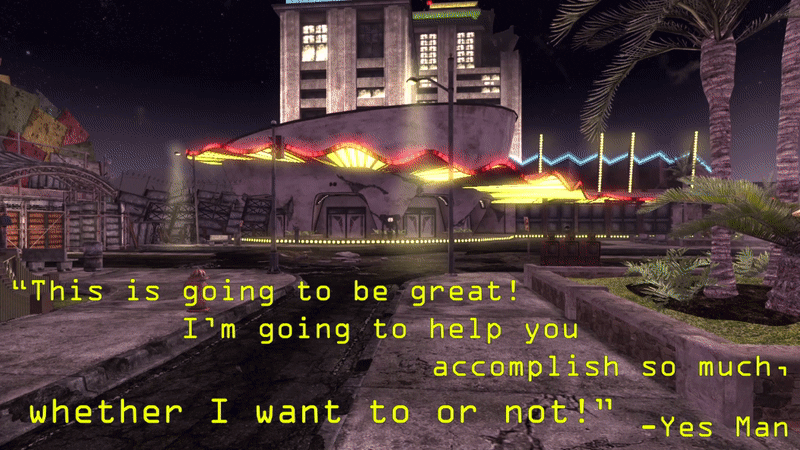
To this day, there aren’t that many role-playing games that offer you the chance to truly do things your own way.
To give the established factions who control the game world the middle finger, rejecting the opportunity to become a highly-effective lackey for someone else, as they attempt to bring about their vision for the world.
To a degree, this is usually because of how difficult such a possibility can be to implement in a way that doesn’t seem forced or illogical.
After all, the game can’t read your mind as you sit in front of the screen and bring to life whatever unique, madcap plan you’ve formulated to take over New Vegas.
Instead, it has to give you a ready-made framework by which you can achieve your goals, with npcs who can give you quests and provide you with information on your options.
This, if implemented badly, could completely ruin your immersion in the game.
If, when gallivanting through the wastes, you randomly came across a character who offered you a ready-made plan to take over the world and offered to give you all the help necessary to pull it off, you’d find it a bit weird.
Fallout New Vegas, however, avoids this, by making the option of taking over New Vegas yourself fit as seamlessly as it can into its main storyline.
For example, the plan itself is originally formulated by Benny, your chequered coat wearing attempted murderer. It’s his main motivation to shoot you in the head at the start of the game.
However, once he meets his end at the hands of either you or the Legion, he can no longer fulfil his plan, but you can.
All you have to do is pay a visit to his suite in the Tops Casino and meet his second-in-command.
Yes Man.
While not the most interesting character in the Fallout franchise, Yes Man might just be my favourite.
This aptly-named securitron is that possibly incongruous character who offers you the keys to the kingdom and willingly helps you to go about unlocking the door.
However, Yes Man has an explainable motivation for doing so.
He can’t not.
It turns out, in order to be able to access information about Mr House through Yes Man, Benny had to program him to openly divulge any and all of the information he knows to anyone at any time, including you.
He’s also pretty much incapable of saying anything negative, even if you do your best to muck up the plan at every turn, leading to a smorgasbord of hilarious dialogue as he attempts to congratulate you for clearly doing the wrong thing.
This is what makes Yes Man more than just a faceless device through which you can achieve world domination.
Instead, he’s a highly self-aware and clever parody of the kind of sycophantic culture that stereo-typically surrounds would-be conquerors (like yourself) or the politicians and corporate CEOs of the real world.
This meshes well with the realistically rather surreal scenario of a former postal worker rising from the grave and deposing an over two hundred year old business mogul to take over a city and defeat two huge armies.
In a game where you naturally face a lot of dark and gritty scenarios, are surrounded by weighty and complex decisions and in which all three of the other main factions take themselves and their ideals very seriously, having quest-lines and characters that provide a degree of levity to balance the experience out is important.
Levity and power fantasy aren’t all that Yes Man and his route can offer though.
He’s also the only option if you want the final say on what happens to many of the smaller factions dotted around the Mojave.
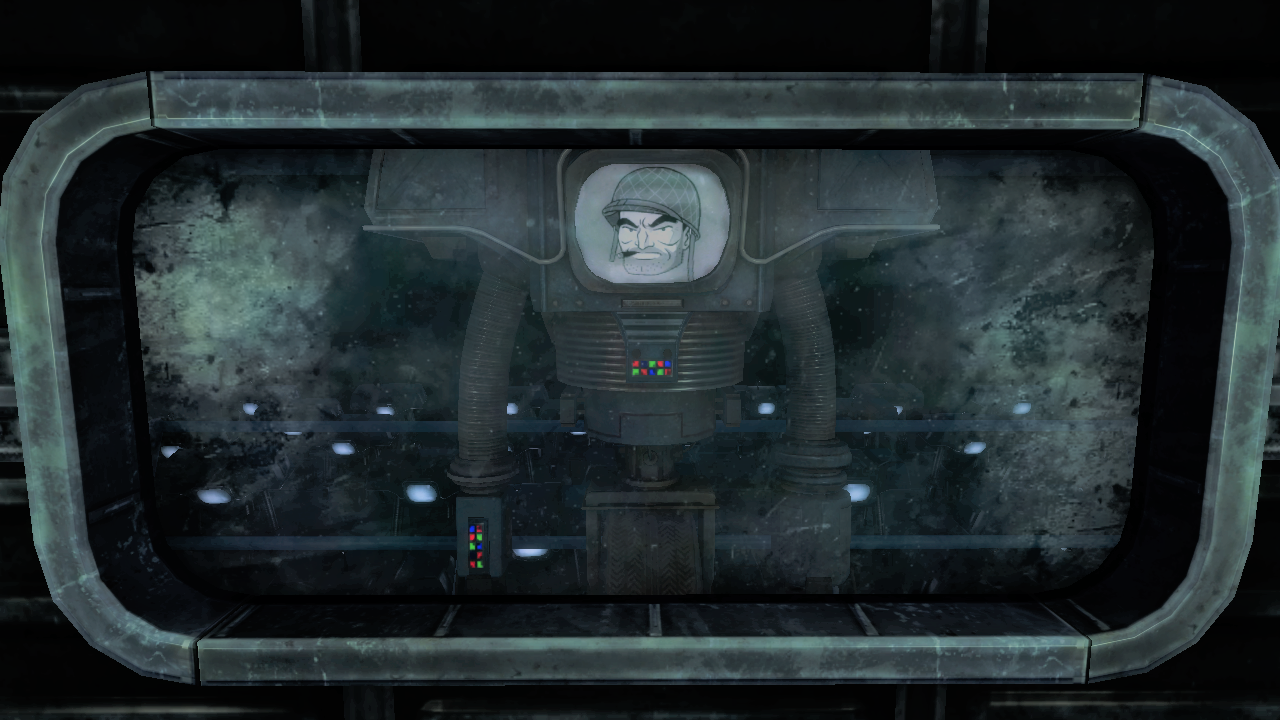
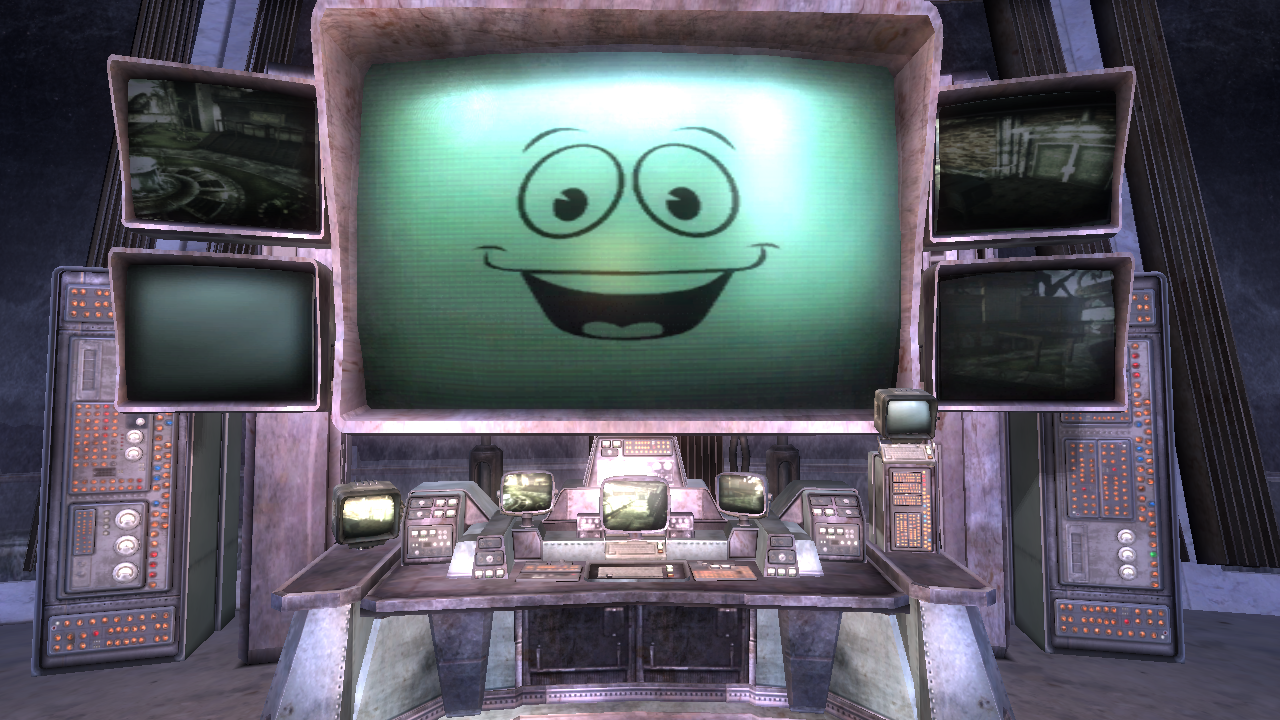
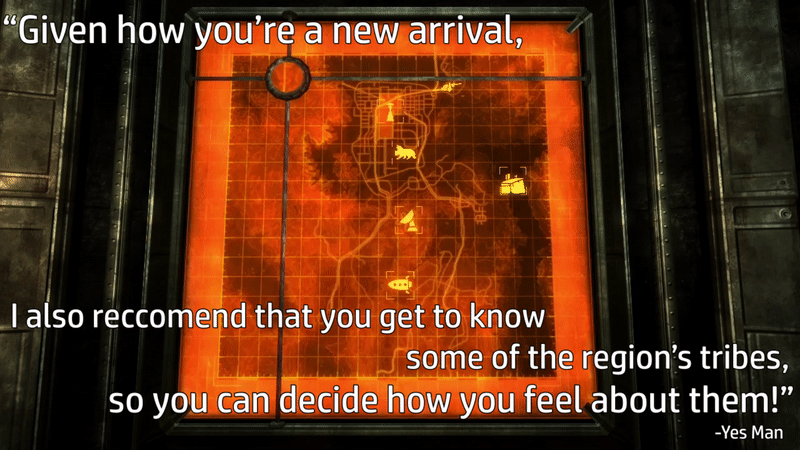
While the NCR, Legion and Mr House may be the most powerful and expansive factions in the Mojave, therefore playing the largest roles in shaping the world around you, the smaller factions and tribes that inhabit the wasteland arguably play just as bigger role in making the wasteland feel alive.
Every game has main factions, massively fleshed-out groups that play a key role in the construction of the game world and the stories that are being told within it.
However, rarely do the minor factions that should fill out any large open world receive a similar amount of attention and development.
To this day, New Vegas remains exemplary in this regard, offering an array of contrasting and unique groups, in a number of interesting locations dotted around the wasteland, for you to investigate and interact with.
Each has its own quest-lines, likeable and nuanced characters and unique rewards for you to experience and it’s these elements that allow them to feel more important than their size compared to the main factions might originally indicate.
The effect is so great that a large section of the main plot can revolve entirely around interacting with them on behalf of your chosen main story faction, judging whether they can be of aid or simply finding a way to dispose of or cripple them if your faction leader deems it necessary.
They also act as a weighty incentive to take over New Vegas yourself, as siding with Yes Man means that, rather than relying on the whims of your chosen overlord, you get to choose which factions are worth your time and effort, making it easier to avoid having to miss out on accruing all of the best rewards they have to offer.
Take, for example, the Brotherhood of Steel. Known for being a primary faction in Bethesda’s modern Fallout titles, New Vegas offers a different vision of the technologically-inclined group.
Rather than being a powerful juggernaut, the Mojave Brotherhood are a depleted force who, while still possessing superior technology to most of the rest of the wasteland, are locked down in a single bunker at Hidden Valley, still reeling from the loss of a war to the NCR.
They can be difficult to even gain access to at first if you don’t know which companion to bring to their front door, have a frosty relationship with the NCR, due to their recent war and bad relations with the Legion and Mr House, both of whom see the Brotherhood as an existential threat.
Sure, if you side with the NCR, you can engineer a difficult reconciliation and alliance between them and the Brotherhood, but if you’re with Caesar or Mr House, you don’t get a choice and they have to be dealt with violently.
This means that you can easily miss out on being trained to use power armour by one of only two in-game factions that can offer to teach you this skill, which many players naturally desire, in addition to losing access to a valuable energy weapon vendor and some other possible minor quest outcomes.
Of course, if you’re the one calling the shots, you won’t have to worry about this, giving that main story choice some additional and arguably less obvious benefits.
There’s also the Great Khans, whose backstory of an old-school raider gang finding themselves less and less welcome in a wasteland that’s slowly becoming more civilised and being forced to relocate frequently to avoid being finally driven to extinction bears a lot of parallels to the fate of Red Dead Redemption 2’s Van Der Linde gang.
The Khans have a long and violent history of warring with the NCR and have thus decided to side with Caesar, choosing not to believe that he’ll just destroy or absorb their gang once the NCR are defeated.
You can break this alliance, if you wish, but the only ways that the Khans won’t end up suffering a negative fate once the main quest is complete are if you either side with Mr House or take over yourself.
Similar consequences await you when dealing with other factions throughout the wasteland, all of whom offer different philosophies, of which you may approve or disapprove.
From the small townships of Goodsprings, Primm and Novac, to the numerous factions located within larger population centres like Freeside and the Strip itself, everyone will formulate an opinion of you and your actions, which, no matter what you choose, will have an impact on both their present and their future.
I’d like to conclude this section by giving a shout out to one more faction, one whose name has taken on a new kind of significance in the year 2020.
The Boomers.
The developers of New Vegas couldn’t have predicted in 2010 that the phrase ‘Ok Boomer’ would become the cultural phenomenon and viral meme that it is in our current time.
However, the fact that it has makes the existence of a faction in the game which satirically commentates on the stereotypical traits of that particular generation, by giving their generational namesake to a group who, as a result of growing up in a vault where guns and other heavy weapons were abundant and carried openly, have become a xenophobic tribe of insular outcasts, holed up in an air force base where they uncontrollably hoard weapons and blow up anyone who comes near their doorstep, even more amusing and clever than it seemed back in 2010.
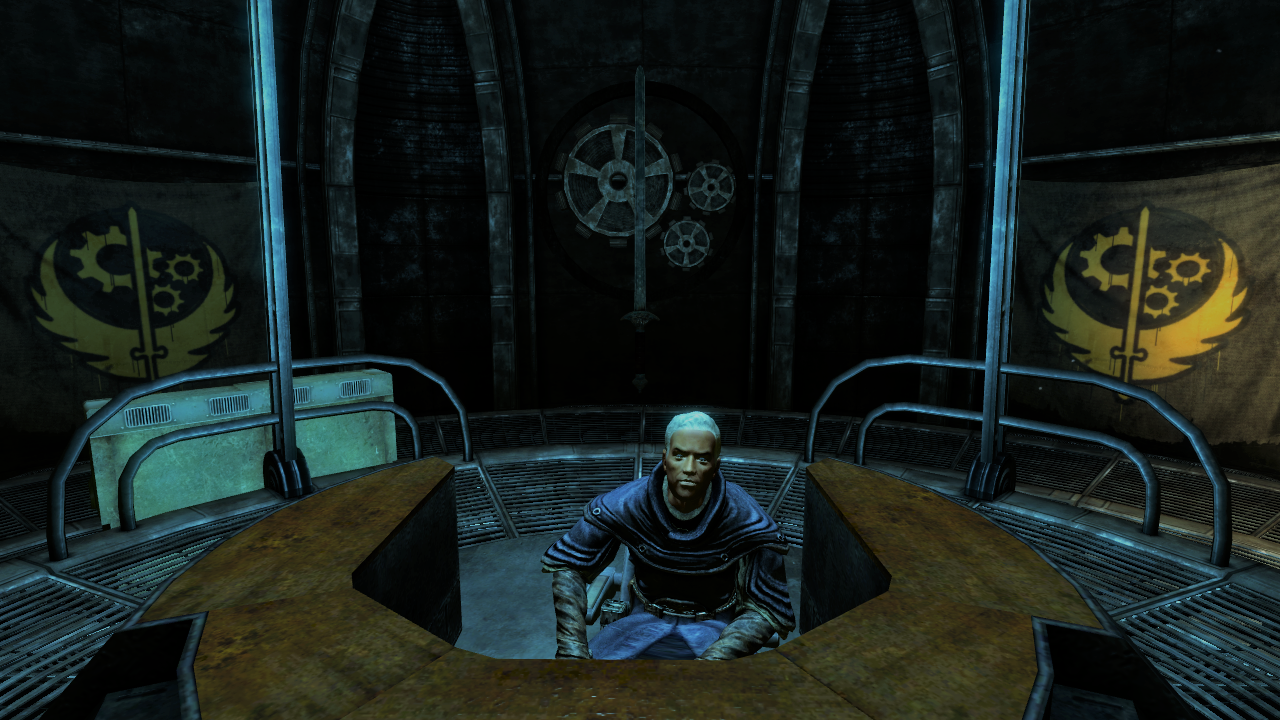
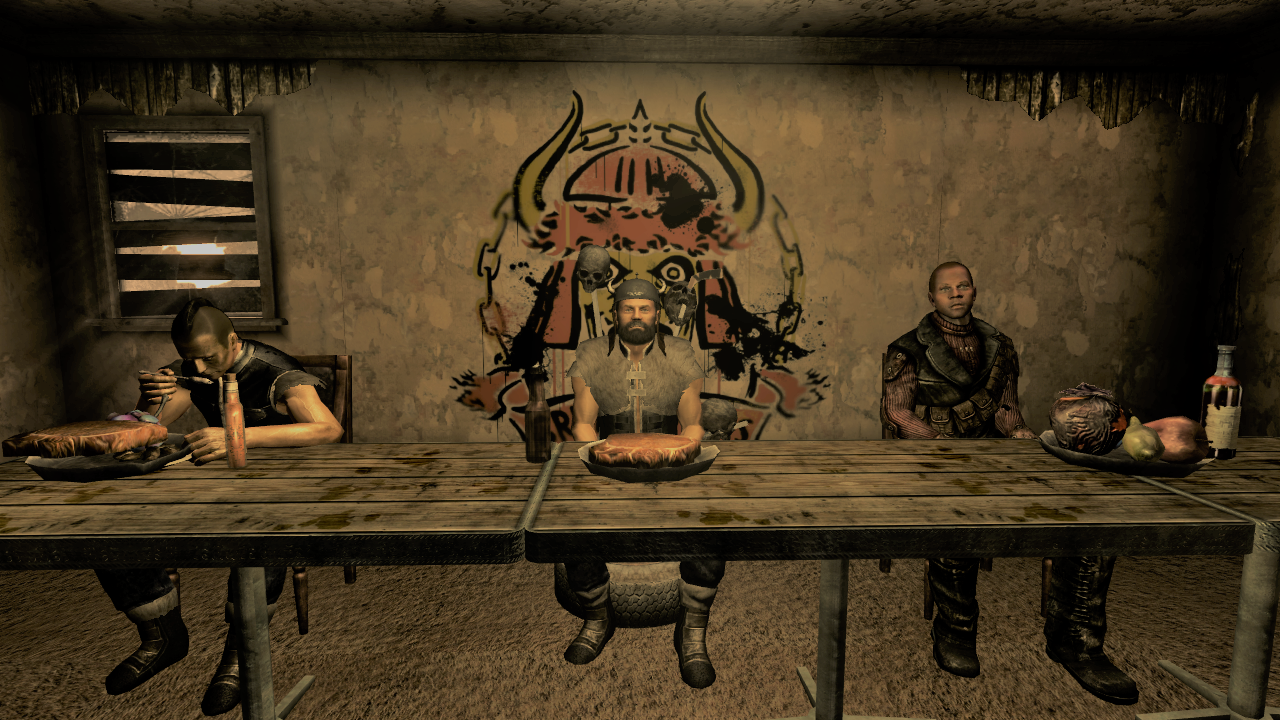
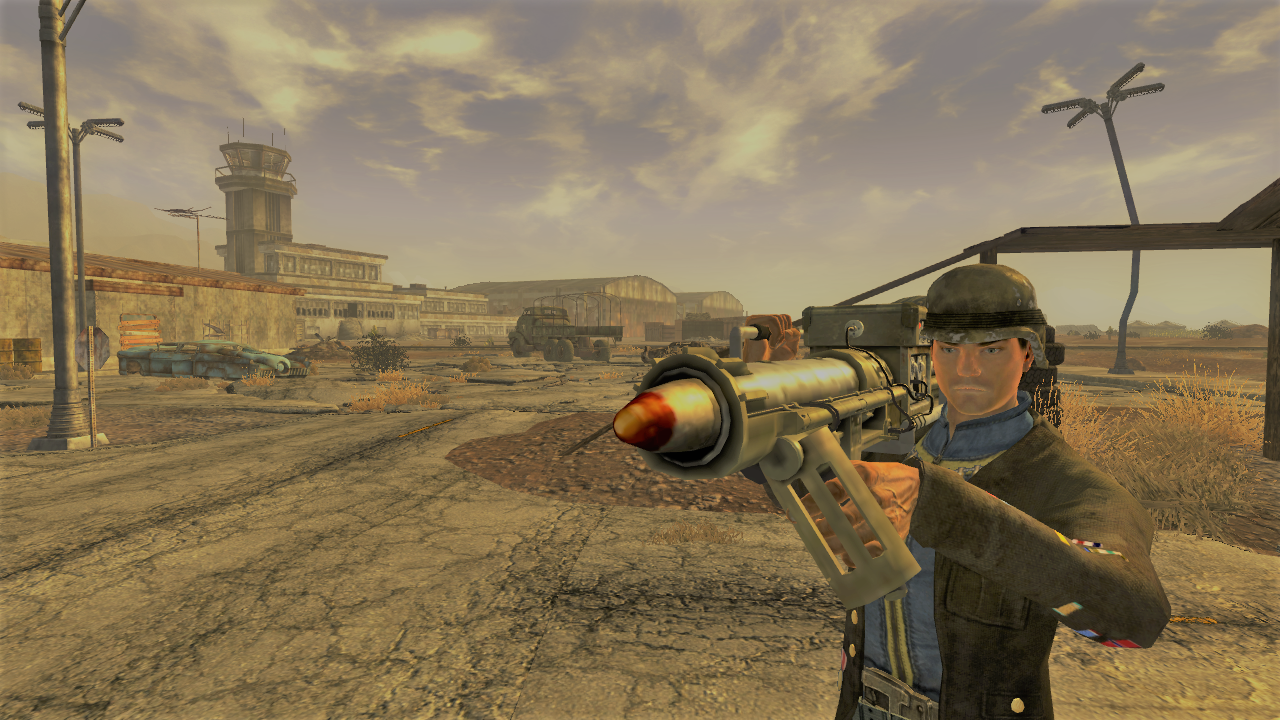
When it comes to achieving an extended lifespan and therefore having a prolonged impact on the landscape of gaming, open world RPGs arguably have a better chance than most other single player games.
Their often massive size and scope, plus their focus on replay-ability and choice and consequence, when added to their low likelihood of being immediately followed up by a sequel only one or two years after their release, puts them in a great position to amass and maintain a large number of players, who'll keep coming back time and time again to discover new secrets, find new ways to experience the game and augment it through modding.
That said, few RPGs fully realise this potential.
Fallout New Vegas is one of the games that really has.
It's a game that still holds up very well ten years on, despite its understandably outmoded graphics and occasionally clunky performance, because its primary strengths lie in areas that can't be rendered obsolete by the relentless forward progression of game design and technology.
Much like the successful and genre-defining RPGs that have followed it in the decade since its release, the likes of Skyrim and The Witcher 3, New Vegas has stood the test of time because it offers a unique and expansive world for players to immerse themselves in.
Populated by a litany of interesting factions and a colourful cast of memorable characters, it's this world that continues to provide the foundation for all of the engaging storytelling and endless role-playing opportunities that continue to define the New Vegas experience to this day.
So, coming up on ten years after all of those couriers were shot in the head for the first time, New Vegas remains a game that'd I'd recommend without hesitation to anyone with even a passing interest in the medium.
Much like the neon-tinged city that provides its namesake, you might find that it just isn't your style.
Or you might find yourself drawn in and never want to leave.
